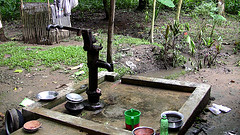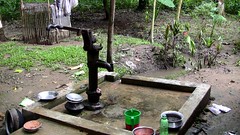Bangladesh – Arsenic Poisoning of a Population in Need of Pure Drinking Water

Bangladesh is grappling with a massive crisis of arsenicosis or chronic arsenic poisoning. A World Bank report shows that arsenic was first detected in the groundwater of Bangladesh and West Bengal in India in the 1990s while a recent study in the British Medical Journal ‘The Lancet’ found that 35-77 million people in Bangladesh suffer from arsenicosis.
A well meaning initiative, started in the 1970s to supply clean, pure drinking water to a population suffering from diarrhea (the main cause of death in children), has led years later to countless thousands of people suffering from arsenic poisoning: UNICEF and other international organizations dug no less than 8,600,000 tube wells in all 64 districts of Bangladesh to supply pure water to the people. Little did they know that this would prove to be a major hazard only a couple of decades later. What the donors failed to do was to measure the arsenic levels in the tube well water. Although a device for measuring arsenic levels was then available, tests for metal impurities were not mandatory. The arsenic was first detected in the water years after the population started manifesting symptoms of the disease – after long exposure to the poisonous chemical.
A UNICEF survey reveals that 57% of tube wells in Bangladesh are contaminated by arsenic. Initially the Government and international organizations were hesitant to uncover the truth, but ultimately, given the sheer magnitude of the problem, the truth came out. In 2000, the World Health Organization(WHO) called this the largest mass poisoning in history as millions of people in the country were affected by it.
Impact
Arsenicosis also has adverse health, social and economic impacts. Arsenic contaminates ground water and its ingestion in excess of 0.01 micrograms per litre of water (according to WHO) over a long time causes changes to the skin and dysfunction or even cancer in different organs including the liver, kidneys, lungs and brain. It also causes changes to the blood vessels of the legs and feet, causing gangrene. Excessive levels of arsenic also lead to diabetes, high blood pressure and reproductive disorders.
There is a tendency to ostracize people in the country with visible symptoms of arsenic poisoning as their organs are affected and there are drastic physical changes in the skin. Ostracization is largely fuelled by ignorance and a misconception that arsenic related ailments are contagious. Those who have them are segregated from the normal social stream. Women are more socially affected because of their lower social status. They are neglected, isolated, abused, abandoned and find it difficult to find a life partner. They are also less likely to talk about arsenic related health problems and more likely to attend to health needs of others than to care for themselves. They also suffer more because they are less well nourished than men.
Arsenicosis also creates an economic burden on families. A large part of the population who suffer from arsenicosis lose their ability to participate in economic life. Employers also dismiss arsenic patients and avoid hiring them. A large percentage (71%) of arsenic affected patients are from low-income groups while 29% are from a middle income group. The high cost of treatment places further burdens on families as the disease is chronic in nature, tests are numerous and remedies uncertain.
Are there remedies?
Even though a large population suffers from arsenicosis, large scale treatment and prevention is still to be put in place. The quest for a remedy has made people return to surface water which is arsenic-free though it might be polluted. What’s more, rain water harvesting is not easy and domestic methods of separating out the arsenic are not well-proven. The arsenic contaminated tube wells had been marked and discarded. But people still do not have effective alternatives.
Dr. Muhammd Yunus, the Nobel Laureate and founder of Grameen Bank in Bangladesh has made an attempt to supply pure water to rural people. He started a joint venture a social business with Veolia Water Ltd to supply pure water to rural communities. In this project water was collected from the surface of rivers, brought to a processing plant, supplied to water points in the village and distributed at low cost to villagers. However, only a small rural area is covered by the project which is also at risk as the Bangladesh Government is in conflict with Dr. Yunus and his ‘Grameen Bank’ and ‘Social Businesses’. The program could be extended if the Government took the initiative to cover a wider area of the country. However nothing of the sort has happened.
Some international organizations advocate deep tube wells but this is also not risk-free as arsenic contaminated water may seap through into the deeper water layer and contaminate it. The method is also too expensive to be useful for rural people.
There is still no answer to the problem of how to mitigate arsenicosis and supply arsenic-free water to a larger population. The future challenge is both to find easy ways to separate out arsenic from contaminated water and ensure a ready supply of arsenic-free pure drinking water to the ailing population and to discover low cost effective treatment for arsenic patients.
Tags: Arsenic, Arsenic Poisoning, bangladesh, ground water, water, water crisis



